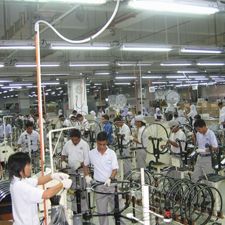PEKAN NANAS, Malaysia (BRAIN)—No blindfolded twisting bus trip, no nondisclosure documents signed with a pricked finger, just six magazine editors with cameras touring Shimano’s Malaysian component factory.
The factory produces all of Shimano’s wheels, including Dura Ace, and all its pedals. Cranks, hubs and some brakes up to the Tiagra level on the road side and to Deore on the mountain side are also made there. Due to a variety of proprietary manufacturing processes in use at the plant Shimano never opened its facility to the press before.
So why open the facility now? Thank the increasingly competitive wheel market. Shimano thinks it has a unique story in the way it produces its wheels and it wants to get the message out: it is not just another wheel company.
“Other makers may talk up robot builds or final hand truing but the experienced hand of a wheel builder through the entire process is still better, much better. So we are committed to hand-building, which may surprise some,” said Devin Walton, Shimano’s public relations manager.
All of Shimano’s wheels, except full-carbon Dura Ace tubulars, are hand-built in Pekan Nanas using components made under the same roof—hubs, spokes, nipples and rims. Though some wheels may have robots stuff spokes in hubs, which is where the mechanization stops, there are no other robots on the floor. High-end Dura Ace clincher wheels are built entirely by hand. Dura Ace tubular wheels are made in Japan.
“Other makers rely on one source for spokes, another source for hubs and someone else for rims to pull their wheels together. However, to provide an engineered wheel system you have to be able to engineer each component part, which is easy for us since we make everything in here under one roof,” Walton added.
Shimano established its factory in Malaysia 17 years ago. Encompassing 89,000 square meters, or 956,000 square feet, the plant employees 2,087 people and is ISO 9001 and 14001—an environmental standard compliant. In addition to bike parts, the factory produces a variety of spinning and bait casting fishing reels.
To that image of white-coated clean-room workers hustling around making microchips, add Dura Ace wheels. All Dura Ace clinchers are made in a clean-room by workers shuffling around in dust booties, meticulous lab uniforms in a climate controlled filtered air environment. In another clean-room, Dura Ace’s WH-7850-C24 CL and deep-section C50 CL hybrid aluminum carbon clincher rims are made, occasionally in 24-hour shifts, to meet its carbon clincher demand.
The pride of the Malaysian factory is its aluminum-carbon hybrid Dura Ace C24-CL rim. The aluminum rim extrusion that forms its core is only 0.55 millimeters thick below the brake track. This inner rim is overlaid with about the same amount of carbon ending up with a final rim weight of 380 grams. The C24 at 1,231 grams a pair, weighs only 150 grams more then Dura Ace’s all carbon C24-TU tubular wheelset, yet sells for $1,300. Consumers can only get C24-CL wheelsets from bike shops beginning in February, since the long development cycle for the C24-CL pushed them past the original equipment sales season, they may appear on production bikes later in the spring.
—Story and picture by Matt Wiebe




